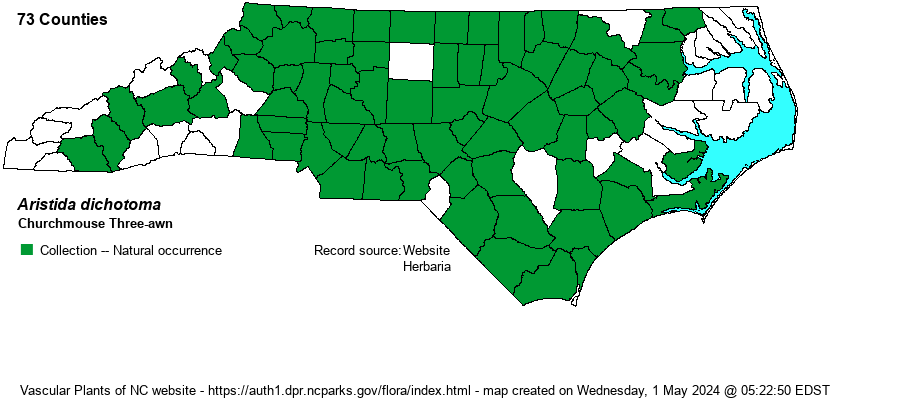| Section 5 » Order Cyperales » Family Poaceae |
Show/Hide Synonym
| taxonName | relationship | relatedTaxonName | relatedTaxonRefText | relComments |
|---|
|
|
|
|
|
|
| Aristida dichotoma | = | Aristida dichotoma var. dichotoma | Fernald (1950) | | | Aristida dichotoma | = | Aristida dichotoma var. dichotoma | Flora of North America (1993b, 1997, 2000, 2002a, 2002b, 2003a, 2004b, 2005, 2006a, 2006b, 2006c, 2007a, 2009, 2010) | | | Aristida dichotoma | = | Aristida dichotoma var. dichotoma | Kartesz (1999) | | | Aristida dichotoma | = | Aristida dichotoma var. dichotoma | | | | Aristida dichotoma | = | Aristida dichotoma var. dichotoma | | | | Aristida dichotoma | = | Aristida dichotoma var. dichotoma | Wofford (1989) | | | Aristida dichotoma | = | Aristida dichotoma var. dichotoma | Wunderlin & Hansen Flora of Florida (3) | | | Aristida dichotoma | = | Aristida dichotoma var. dichotoma | Flora of West Virginia | | | Aristida dichotoma | = | Aristida dichotoma var. dichotoma | Kesler, Anderson, & Hermann (2003)=V. Key adapted, in part, from Z. | | | Source: Weakley's Flora |
|
| Author | Michaux | |
| Distribution | Nearly throughout the state; scarce in the southern Mountains and in the northern outer Coastal Plain; absent from the Outer Banks/barrier islands.
ME to WI, south to FL and TX. | |
| Abundance | Frequent to common across the state, except infrequent to fairly common in the southern mountains, and very rare in the northeastern counties. Plants are usually very numerous where found. | |
| Habitat | Dry to xeric, open, sandy soil of roadsides, powerline clearings, scrapes, borrow pits, old fields, waste ground. |
| Phenology | Flowering and fruiting August-October. | |
| Identification | Churchmouse Three-awn is a low-growing (under 1.5 feet tall), multi-stemmed, "branchy" grass that is grayish-green in color (glaucescent). The stems usually are not erect, but ascend at an angle. It is very similar to the less common A. curtissii but it differs mainly by shorter lemma (less than 6 mm long vs. 7-8 mm long in A. curtissii). | |
| Taxonomic Comments | None, though a few references include A. curtissii within it, as a variety.
The genus Aristida is most notable for the 3 hairlike awns which project from each floret. The central awn is almost always thicker than the other 2 awns. The awns may stand erect, especially during the early flowering period, but in most species eventually are bent parallel to the ground. In some species, only the central awn is bent, while the other 2 remain erect. In some species, all awns are the same length, while in other species the central awn is distinctly longer. The awns have tiny barbs which catch onto hair and fur, and florets will even hitch a ride up the inside of your pants! | |
| Other Common Name(s) | Forktip Three-awn, Poverty Grass | |
| State Rank | S5 | |
| Global Rank | G5 | |
| State Status | | |
| US Status | | |
| USACE-agcp | FACU link |
| USACE-emp | UPL link |

